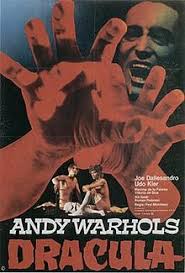THE CLASSIC HORROR FILM
By Jeffrey-Baptiste Tarlofsky
By Jeffrey-Baptiste Tarlofsky
Lesson 23 consists of 8 video lectures and transcripts of those lectures, and 7 film excerpts. Start with the lecture, Part 1, and continue down the page in sequence until you reach the end of the lesson.
レッスン23は8本のビデオレクチャー(レクチャーのテキストがビデオレクチャーの下に記載されています)と7本の動画で構成されています。
このレッスンは、ページをスクロールダウンしながら最初から順番に動画を見たりテキストを読んでください。
Part 1 – To recapitulate the points I made in the previous lecture: the source of “evil” in the classic Hollywood horror film is often to be found in the castles of the nobility, and the nobles themselves are either depicted as monsters (e.g., vampires or werewolves) or are closely linked to the creation or birth of the monsters in the films (e.g., the Frankenstein monsters). The nobles victimize the local people by extorting their crops or money in the form of “taxes”. Vampire films depict this victimization by having the nobles actually drink the blood of the local peasants. “Blood” in those films symbolizes either the peasants’ money or labor (i.e., their “blood and sweat”).
“Blood” is also a symbol of family lineage. European nobility was obsessed with the “purity” of their “bloodlines” (their DNA) and so engaged in the practice of “inbreeding” (marriage within families), which ironically led to many genetic abnormalities such as facial deformations or even hypertrichosis (the condition that makes people look like werewolves). The European nobility were quite literally the definition of monsters: humans of extreme ugliness and/or evil.
 The goal of the nobility as a class and an institution was to perpetuate itself by making sure there were always legitimate male heirs to inherit the property, power, and titles of “Emperor”, “King”, “Duke”, “Marquis”, “Earl”, “Baron” or “Count”. Although noblemen (and even kings and emperors) might have many illegitimate children, only the child of a legal (that is, church recognized) marriage could use his father’s name and inherit his title (unless the father was without a legitimate heir and chose to recognize an illegitimate child as his rightful heir). In most, but certainly not all cases, it was the oldest male child who inherited titles, power, and property. Women were almost always under the authority of their fathers, husbands, or oldest male relatives.
The goal of the nobility as a class and an institution was to perpetuate itself by making sure there were always legitimate male heirs to inherit the property, power, and titles of “Emperor”, “King”, “Duke”, “Marquis”, “Earl”, “Baron” or “Count”. Although noblemen (and even kings and emperors) might have many illegitimate children, only the child of a legal (that is, church recognized) marriage could use his father’s name and inherit his title (unless the father was without a legitimate heir and chose to recognize an illegitimate child as his rightful heir). In most, but certainly not all cases, it was the oldest male child who inherited titles, power, and property. Women were almost always under the authority of their fathers, husbands, or oldest male relatives.
 In addition to blood being an important symbol for money, labor, or heredity, flowers were another important symbol in our films. In Frankenstein, Maria offers the monster a flower (symbolizing both her innocence and the innocence of the “child” monster who smiles when he receives this gift), but the flowers they play with are transformed into symbols of death when the monster mistakenly treats Maria like a “flower” to see her float and drown by accident. This segues perfectly into the scene in which the Baron reveals the preserved (but dead) orange blossoms as symbols of the Frankenstein family (artificially preserved like the institution of nobility itself). Flowers were also important symbols in both Dracula and The Wolf Man. In Dracula, the flower aconitum or “wolf’s bane” (not garlic blossoms) is used to keep Dracula away from his intended victim, Mina. In The Wolf Man, we recall both Gwendolyn and Jenny reciting the poem: “Even a man who is pure in heart and says his prayers by night, may become a wolf when the wolfbane blooms and the autumn moon is bright”.
In addition to blood being an important symbol for money, labor, or heredity, flowers were another important symbol in our films. In Frankenstein, Maria offers the monster a flower (symbolizing both her innocence and the innocence of the “child” monster who smiles when he receives this gift), but the flowers they play with are transformed into symbols of death when the monster mistakenly treats Maria like a “flower” to see her float and drown by accident. This segues perfectly into the scene in which the Baron reveals the preserved (but dead) orange blossoms as symbols of the Frankenstein family (artificially preserved like the institution of nobility itself). Flowers were also important symbols in both Dracula and The Wolf Man. In Dracula, the flower aconitum or “wolf’s bane” (not garlic blossoms) is used to keep Dracula away from his intended victim, Mina. In The Wolf Man, we recall both Gwendolyn and Jenny reciting the poem: “Even a man who is pure in heart and says his prayers by night, may become a wolf when the wolfbane blooms and the autumn moon is bright”.
In this lesson, we will further explore both symbolism in classic horror films and the way in which the films explore class systems. To begin with, we return to the important scene in Bram Stoker’s Dracula when Prince Vlad transforms himself into a vampire after learning of the suicide of his wife Elizabeta.
Part 2 – Those of you familiar with Christianity will recall that on the very same night that Judas betrays Jesus to the Romans, Jesus and his disciples were in hiding and held what is known as “The Last Supper”. Jesus tells his disciples that this will be their last meal together because one of them will betray him (which Judas does after they all go to sleep). This meal became the basis for one of the most important of all rituals, or “sacraments”, in Christianity known as “Holy Communion” or “taking the Eucharist*”.
The word “Eucharist” is derived from the Greek word eucharistia, meaning “thanksgiving.” This term originated in the 1st or 2nd century A.D. as early Christians commemorated Christ’s Last Supper with thanksgiving. During the meal, Jesus gave his disciples bread to eat and wine to drink and commanded them to eat the bread and drink the wine “in memory of me” while referring to the bread as “my body” and the cup of wine as “my blood”. The bread and wine themselves are also often referred to as the “Eucharist “. During the ceremony, a priest or other who presides gives members of his church bread and wine. Christians generally recognize a special “presence of Christ” in this rite, though they differ about exactly how, where, and when Christ is “present”. Some reformed Christian traditions say the sacrament is only symbolic, but for almost two thousand years the strict interpretation of “taking the Eucharist” involved the belief that the wine really does turn into the “blood of Christ” (Jesus) and the bread really is his body.
This is why the scene we have just seen in Bram Stoker’s Dracula is not only scary to Christians it is genuinely horrifying. Dracula is corrupting one of the most sacred rituals in Christianity. He is not “becoming one with God” as is the purpose of the ritual…but instead, he is becoming one with God’s enemy, Satan. Even though I am not a Christian, this scene “chills my blood“, as the saying goes, because I understand just how serious the taboo being broken here is. To mock the taking of the Eucharist in this way is to commit the unpardonable sin of blasphemy. Of course, we know exactly what blasphemy is because we discussed it when we studied Frankenstein. By creating life, Frankenstein committed blasphemy by doing something only God should have the power to do. Dracula’s corrupting of the sacrament of holy communion is surely just as great a sin.
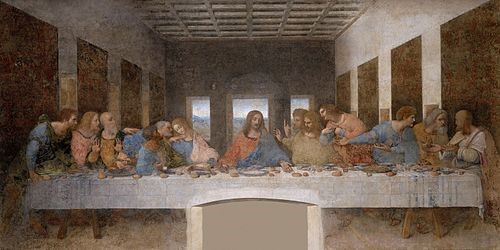
The Last Supper by Leonardo da Vinci (circa 1490)
Remember that what Dracula is mocking and corrupting in this scene is the ritual in which a believing Christian drinks wine and believes it is the blood of Christ. This brings us to the important symbolism of wine in horror films. The following scene takes on new meaning once we understand this.
Part 3 – “I don’t drink…wine” has become one of the most cherished quotes from any horror film and is often used in a joking manner between friends. But when we think about the scene from Bram Stoker’s Dracula this “joke” isn’t quite so funny. It is also more meaningful because the rules in many denominations of Christianity require one to be both a Christian and “free of sin” during the taking of the Eucharist (drinking the wine and eating the bread). In other words, Dracula, in some sense actually cannot drink wine because he has stopped being a Christian and placed himself in league with Satan.
Islam forbids the drinking of alcohol entirely, but in Christianity drinking wine is actually required (although some Christians do substitute non-alcoholic grape juice for wine when they take the Eucharist). However, drunkenness is considered a sin. Drunkenness is not only a sin in itself for Christians, it also puts one in a state of mind where one might commit other sins.
Consider these two scenes from Curse of the Werewolf.
Part 4 – The Marquis di Siniestro is, as you will recall, a symbol of Satan and he uses wine to intoxicate the beggar in order to further rob him of his dignity and humanity. Once he is drunk enough to dance he receives his reward: “Here’s your bone, come and get it like a good dog”. Drunk on the wine, the beggar makes the lewd remark which gets him thrown into the dungeon where he will spend the rest of his life as an increasingly degenerate character, one who will eventually rape the servant girl.
As an adult Leon goes to work in the vineyards, a perfectly honest kind of work, but again he is working for a man who is selfish, rude, and extremely class-conscious. Cristina’s father would never consider Leon eligible to marry his daughter, which is why Leon finds himself out drinking with Jose on Saturday night. His drunkenness and the influence of the full moon are what allow the evil spirit inside him to emerge and kill both the prostitute and Jose. In Western culture, drunkenness is never an excuse for bad behavior.
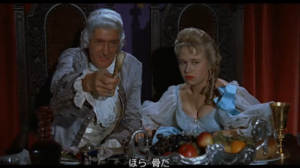
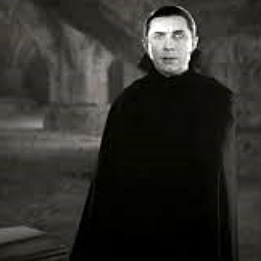
To Americans (and to Japanese when I first came here), wine had an exotic and sophisticated air (although this was not true in Europe where everyone drinks wine). In America (and Japan) wine used to be a drink mainly for special occasions or the upper classes. This is no longer true, either in America or Japan, or the world where wine production has exploded and wine is actually cheaper than beer in some places! But the fact is, wine can be very, very expensive. A single bottle of Romanee-Conti (1945), a French Burgundy, sold at auction for $558,000. Yikes! When we think of the European nobility we think of them in their castles and every castle in Europe would have had extensive underground basements that included wine cellars. These are the perfect conditions for storing wine, which requires a constant level of mild humidity as well as a cool and dark place to rest. In other words, the wine cellars in the depths of the castle would have been very close to the family crypts where the bodies of generations of the nobility were kept….and where the vampires would be hiding from the sunlight.
Dracula and his wives in the crypt of Castle Dracula
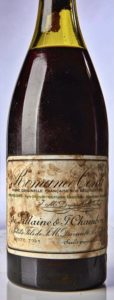
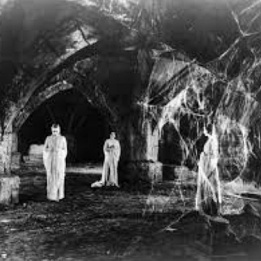
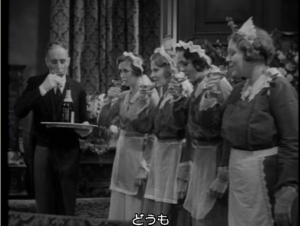 Part 5 – Notice also in the Frankenstein except that we find ourselves in the basements and can see the wine stored there. Then Baron Frankenstein tells us that the wine he is serving on the day of his son’s wedding was put in those cellars by his grandfather. Wine, just like the orange blossoms, becomes a symbol of the Frankenstein family’s great age. The Baron says not to waste the old wine on the servants but does treat each of them to a glass of champagne. But for the villagers? Beer. When we hear the music from the village the Baron says, “It must be the boys and girls of the village”. But it is actually the whole village who have come to his window. The “boys and girls” remark is putting the villagers in their proper place…as his children and dependents. He jokes about there being plenty of beer for all of them (as if they only cared about getting drunk), and he jokes with his guests, “Tomorrow they’ll all be fighting again”…like children. Nor is it just to the peasant villagers that the Baron condescends. He is also openly rude to both Professor Waldman and Herr Vogel, the Mayor of the town.
Part 5 – Notice also in the Frankenstein except that we find ourselves in the basements and can see the wine stored there. Then Baron Frankenstein tells us that the wine he is serving on the day of his son’s wedding was put in those cellars by his grandfather. Wine, just like the orange blossoms, becomes a symbol of the Frankenstein family’s great age. The Baron says not to waste the old wine on the servants but does treat each of them to a glass of champagne. But for the villagers? Beer. When we hear the music from the village the Baron says, “It must be the boys and girls of the village”. But it is actually the whole village who have come to his window. The “boys and girls” remark is putting the villagers in their proper place…as his children and dependents. He jokes about there being plenty of beer for all of them (as if they only cared about getting drunk), and he jokes with his guests, “Tomorrow they’ll all be fighting again”…like children. Nor is it just to the peasant villagers that the Baron condescends. He is also openly rude to both Professor Waldman and Herr Vogel, the Mayor of the town.
 Part 6 – The Baron and the Burgermeister are obviously not equals even though the Burgermeister is the elected leader of the town. It is obvious that the real power in this village lies with the nobleman, Baron Frankenstein. His concern is with seeing his son married — a “son (and heir) to the house of Frankenstein”.
Part 6 – The Baron and the Burgermeister are obviously not equals even though the Burgermeister is the elected leader of the town. It is obvious that the real power in this village lies with the nobleman, Baron Frankenstein. His concern is with seeing his son married — a “son (and heir) to the house of Frankenstein”.
Blood, wine, and weddings: we now understand the symbolism of the blood and the wine in horror films and it is clear that weddings were crucial for the continuation of the system of hereditary nobility that ruled Europe.
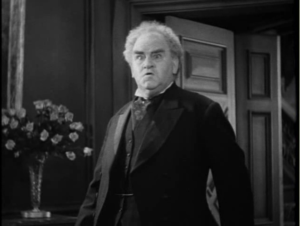 But that nobility is in decay, corrupt, and fallen into evil ways. Its blood has grown corrupt too, which is clear from the number of monstrous deformities that plague the royal and noble houses of Europe. One of the most telling of the genetic diseases that afflicted these families was hemophilia, a rare disorder in which blood doesn’t clot normally because it lacks sufficient blood-clotting proteins. Someone with hemophilia bleeds for a longer time after an injury and even minor injuries can be life-threatening. Yet the entire basis for the power of the nobility was the fact that their ancestors were warriors. Now some of these nobles are too frail to even ride a horse, let alone lead a charge on one. There is a notion that noble blood is attenuated (i.e., reduced in force, effect, or value…reduced in thickness, made more “watery”) or even diseased as is shown in the following excerpt from Curse of the Werewolf.
But that nobility is in decay, corrupt, and fallen into evil ways. Its blood has grown corrupt too, which is clear from the number of monstrous deformities that plague the royal and noble houses of Europe. One of the most telling of the genetic diseases that afflicted these families was hemophilia, a rare disorder in which blood doesn’t clot normally because it lacks sufficient blood-clotting proteins. Someone with hemophilia bleeds for a longer time after an injury and even minor injuries can be life-threatening. Yet the entire basis for the power of the nobility was the fact that their ancestors were warriors. Now some of these nobles are too frail to even ride a horse, let alone lead a charge on one. There is a notion that noble blood is attenuated (i.e., reduced in force, effect, or value…reduced in thickness, made more “watery”) or even diseased as is shown in the following excerpt from Curse of the Werewolf.
Part 7 – In old age, the Marquis has physically degenerated and his head is wrapped in bandages. The bandages are a telltale sign that he is suffering from late-stage or tertiary syphilis (a sexually transmitted disease) that can cause blindness, heart disease, liver malfunction, decay of bones, and twisting of the skeletal structure…and insanity. In other words, in late-stage syphilis, someone can end up looking and acting like a “monster”. For example, the great European noble, Cesare Borgia (the illegitimate son of a Pope), was renowned as a military man and statesman but by the time he was killed in an ambush, he was so eaten away by syphilis that he wore a leather mask over half his face.
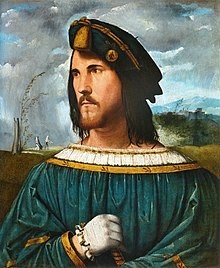 When Bram Stoker wrote Dracula in 1897, he was keenly aware of the degeneration of the European nobility and Count Dracula’s search for “new blood” in London seems to suggest an attempt not only to find better hunting grounds but also less attenuated blood among the upper classes. Yet, Dracula cannot bring himself back to true life with the blood of his victims, he can only prolong his existence as nosferatu. But he can taint their blood with his own corrupt blood, making them like himself, undead. Now consider the next excerpt.
When Bram Stoker wrote Dracula in 1897, he was keenly aware of the degeneration of the European nobility and Count Dracula’s search for “new blood” in London seems to suggest an attempt not only to find better hunting grounds but also less attenuated blood among the upper classes. Yet, Dracula cannot bring himself back to true life with the blood of his victims, he can only prolong his existence as nosferatu. But he can taint their blood with his own corrupt blood, making them like himself, undead. Now consider the next excerpt.
Part 8 – The vampire tells us that the novel Dracula made him feel sad because Dracula had “no servants”. This is perhaps exactly the kind of shallow, selfish, status-conscious thinking among the nobility that best showed how decayed they really were. Dracula remembers his past military glories of hundreds of years ago, but the vampire in the film pities him because he is “reduced to setting his own table” (Oh, the shame!).
And speaking of reduced status, by 1974, Hammer Studios had run out of new ideas for the old Universal monsters and was wrapping up its Dracula films. But, as we know, Dracula never really dies…at least not as a character in the movies. In that year, independent filmmaker Paul Morrisey, with encouragement from fellow director Roman Polanski, agreed to make a bizarre version of the Dracula story that was originally called “Andy Warhol’s Dracula”. When he was asked what he had to do with the production, Andy Warhol (the renowned pop artist) replied, “I go to the cast parties”. The film was later renamed Blood for Dracula. It has been called “trash” and “pornography” by various critics.
In fact, the film is a true document of its time and also makes explicit (stated clearly and in detail, leaving no room for confusion or doubt.) many of the things we have seen as implicit (suggested, but not directly expressed) in the horror films we have studied. Take a look below.
